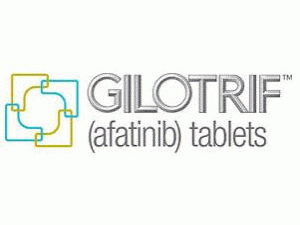阿法替尼,阿法替尼片Afatinib(Gilotrif 20mg Tablets)
 药店国别:无
产地国家:美国
处方药:是
所属类别: 20mg毫克/片 30片/瓶
包装规格: 20mg毫克/片 30片/瓶
计价单位:瓶
生产厂家中文参考译名:无
生产厂家英文名:Boehringer Ingelheim Pharmaceuticals Inc
原产地英文商品名:GILOTRIF 20mg/tab 30tabs/bottle
原产地英文药品名:afatinib
中文参考商品译名:GILOTRIF 20毫克/片 30片/瓶
中文参考药品译名:阿法替尼
曾用名:无
药店国别:无
产地国家:美国
处方药:是
所属类别: 20mg毫克/片 30片/瓶
包装规格: 20mg毫克/片 30片/瓶
计价单位:瓶
生产厂家中文参考译名:无
生产厂家英文名:Boehringer Ingelheim Pharmaceuticals Inc
原产地英文商品名:GILOTRIF 20mg/tab 30tabs/bottle
原产地英文药品名:afatinib
中文参考商品译名:GILOTRIF 20毫克/片 30片/瓶
中文参考药品译名:阿法替尼
曾用名:无
简介
2013年7月12日,美国食品药品管理局(FDA)宣布,已批准将Gilotrif(阿法替尼)用于治疗在伴随诊断检测(therascreen EGFR RGQ PCR试剂盒)中发现有表皮生长因子(EGFR)外显子19删除或外显子21 L858R取代基因突变的晚期(转移性)非小细胞肺癌(NSCLC)患者。 Gilotrif是一种酪氨酸激酶抑制剂,可阻断促进癌细胞发育的蛋白质。在一项纳入345例EGFR突变性转移性NSCLC患者的临床研究中,明确了Gilotrif的安全性和有效性。 将受试者随机分组,给予Gilotrif或不超过6个周期的培美曲塞加顺铂治疗。结果显示,接受Gilotrif治疗者的无进展生存期较接受化疗者延长了4.2个月。两组总生存期未见统计学差异。 与使用Gilotrif相关的常见不良反应包括腹泻、类似痤疮的皮肤突起、皮肤干燥、瘙痒、口腔炎症、甲沟炎、食欲减退、体重减轻、膀胱炎、鼻衄、鼻溢、发热、眼部炎症和低钾血症。 严重不良反应包括可导致肾衰竭和重度脱水的腹泻、重度皮疹、肺部炎症和肝脏毒性。 美国FDA药物评价和研究中心血液学和肿瘤学室主任Richard Pazdur,M.D.说:“今天的批准进一步示范更多了解所患疾病的分子通路可能导致靶向治疗的发展, ”“Gilotrif是今年被批准对有其肿瘤有EGFR外显子19缺失或外显子21 L858R取代突变未治疗的转移NSCLC患者第二个药物。 ” 美国FDA装置和放射卫生中心在体外诊断和放射卫生室主任Alberto Gutierrez,Ph.D.说:“协同诊断测试和药物的批准在肿瘤学是重要发展,因为它们帮助我们对需要它们患者的安全和有效治疗。 ’”优先审评GILOTRIF™(afatinib)为获美国批准口服片剂 美国初次批准:2013 适应证和用途 GILOTRIF是一种激酶抑制剂适用为有转移非小细胞肺癌(NSCLC)患者一线治疗其肿瘤有当用FDA批准的测试检出的表皮生长因子受体(EGFR)外显子19缺失或外显子21(L858R)取代突变。 使用限制 尚未在肿瘤有其他EGFR突变患者中确定GILOTRIF的安全性和疗效。 剂量和给药方法 (1)推荐剂量:40mg口服,每天1次• (2)指导患者在进餐前至少1小时或后2小时服用GILOTRIF 剂型和规格片:40mg,30mg,和20mg 禁忌证:无 警告和注意事项 (1)腹泻:腹泻可能导致脱水和肾衰。对严重和对抗腹泻药物无反应延长腹泻不给GILOTRIF。 (2)大疱和剥脱性皮肤疾病:0.15%患者中生严重大疱,起泡,和去角质病变。对威胁生命的皮肤反应终止药物。对严重和延长皮肤反应不给GILOTRIF。 (3)间质性肺病(ILD):在1.5%患者发生。对肺症状急性发作或恶化不给GILOTRIF。如被诊断ILD终止 GILOTRIF。 (4)肝毒性:在0.18%患者中发生致命性肝损伤。用定期肝检验监视。对肝检验严重或恶化不给或终止 GILOTRIF。 (5)角膜炎:在0.8%患者中发生。不给GILOTRIF对角膜炎评价。对确证溃疡性角膜炎不给或终止GILOTRIF (6)胚胎胎儿毒性:可致胎儿危害。劝告女性对胎儿潜在危害和使用高效避孕。 不良反应 最常见不良反应(≥20%)是腹泻,皮疹/痤疮样皮炎,口腔炎,甲沟炎,干皮肤,食欲减低,瘙痒。 药物相互作用 P-gp抑制剂的共同给药可能增加afatinib暴露。如不能耐受每天减低GILOTRIF 10 mg。慢性Pgp诱导剂口服的共同给药可能减低afatinib暴露。当耐受时每天增加GILOTRIF 10 mg。 在特殊人群中使用哺乳母亲:终止药物或哺乳。 一般描述GILOTRIF片含afatinib,一种酪氨酸激酶抑制剂是一个4-anilinoquinazoline。Afatinib以二马来酸酯盐存在, 化学名:2-butenamide,N-[4-[(3-chloro-4-fluorophenyl)amino]7-[[(3S)-tetrahydro-3-furanyl]oxy]-6-quinazolinyl]-4-(dimethylamino)-,(2E)-,(2Z)-2-butenedioate (1:2)。 其结构式为;Afatinib二马来酸酯盐是一种白色至棕黄色份,水溶性和吸湿性,经验式C32H33ClFN5O11,和分子量718.1 g/mol。为口服给药GILOTRIF片可得到40mg,30mg,或20 mg afatinib(分别等同于59.12 mg,44.34mg,或29.56mg afatinib二马来酸酯盐)。 GILOTRIF的无活性成分如下:片芯:一水乳糖,微晶纤维素,交联聚乙烯吡咯烷酮,胶态二氧化硅,硬脂酸镁。壳:羟丙甲纤维素,聚乙二醇,二氧化钛,滑石粉,聚山梨醇80,FD&C蓝No. 2 (仅40mg和30mg片)。 作用机制 Afatinib与EGFR(ErbB1),HER2 (ErbB2),和HER4 ErbB4)的激酶结构域共价结合和不可逆地抑制酪氨酸激酶自身磷酸化,导致ErbB信号的下调。Afatinib显示自身磷酸化的抑制作用和在体外表达野生型EGFR细胞株的增殖或表达选择性EGFR外显子19缺失突变或外显子21 L858R突变,包括在患者中在可到达的afatinib浓度时,至少暂时,某些有一种次发T790M突变。 此外,在体外afatinib抑制过表达HER2细胞株的增殖。在植入肿瘤或过表达野生型 EGFR或HER2或在一种EGFR L858R/T790M双突变体模型裸鼠中用afatinib治疗导致肿瘤生长的抑制。英文版说明
IMPORTANT SAFETY INFORMATIONWARNINGS AND PRECAUTIONSDiarrhea•Diarrhea has resulted in dehydration with or without renal impairment; some of these cases were fatal. In the pivotal study, diarrhea occurred in 96% of patients treated with GILOTRIF (n=229), of which 15% was Grade 3 in severity and occurred within the first 6 weeks. Renal impairment as a consequence of diarrhea occurred in 6.1% of patients treated with GILOTRIF, out of which 3 (1.3%) were Grade 3.•For patients who develop prolonged Grade 2 diarrhea lasting more than 48 hours or greater than or equal to Grade 3 diarrhea, withhold GILOTRIF until diarrhea resolves to Grade 1 or less, and resume GILOTRIF with appropriate dose reduction.Bullous and Exfoliative Skin Disorders•Grade 3 cutaneous reactions characterized by bullous, blistering, and exfoliating lesions occurred in 6 (0.15%) of the 3865 patients who received GILOTRIF across clinical trials. In the pivotal study, the overall incidence of cutaneous reactions consisting of rash, erythema, and acneiform rash was 90%, and the incidence of Grade 3 cutaneous reactions was 16%. In addition, the incidence of Grade 1-3 palmar-plantar erythrodysesthesia syndrome was 7%. Discontinue GILOTRIF in patients who develop life-threatening bullous, blistering, or exfoliating lesions. For patients who develop prolonged Grade 2 cutaneous adverse reactions lasting more than 7 days, intolerable Grade 2, or Grade 3 cutaneous reactions, withhold GILOTRIF until the adverse reaction resolves to Grade 1 or less, and resume GILOTRIF with appropriate dose reduction.Interstitial Lung Disease (ILD)•ILD or ILD-like adverse reactions (e.g., lung infiltration, pneumonitis, acute respiratory distress syndrome, or alveolitis allergic) occurred in 1.5% of the 3865 patients who received GILOTRIF across clinical trials; of these, 0.4% were fatal. The incidence of ILD appeared to be higher in patients of Asian ethnicity (2.1%) as compared to non-Asians (1.2%). In the pivotal study, the incidence of Grade ≥3 ILD was 1.3% and resulted in death in 1% of GILOTRIF-treated patients.•Withhold GILOTRIF during eva luation of patients with suspected ILD, and discontinue GILOTRIF in patients with confirmed ILD.Hepatic Toxicity•In 3865 patients who received GILOTRIF across clinical trials, 10.1% had liver test abnormalities, of which 7 (0.18%) were fatal. In the pivotal study, liver test abnormalities of any grade occurred in 17.5% of the patients treated with GILOTRIF.•Obtain periodic liver testing in patients during treatment with GILOTRIF. Withhold GILOTRIF in patients who develop worsening of liver function. In patients who develop severe hepatic impairment while taking GILOTRIF, treatment should be discontinued.Keratitis•Keratitis, characterized as acute or worsening eye inflammation, lacrimation, light sensitivity, blurred vision, eye pain, and/or red eye occurred in 0.8% of patients treated with GILOTRIF among 3865 patients across clinical trials. Keratitis was reported in 5 (2.2%) patients in the pivotal study, with Grade 3 in 1 (0.4%). Withhold GILOTRIF during eva luation of patients with suspected keratitis, and if diagnosis of ulcerative keratitis is confirmed, treatment with GILOTRIF should be interrupted or discontinued. If keratitis is diagnosed, the benefits and risks of continuing treatment should be carefully considered. GILOTRIF should be used with caution in patients with a history of keratitis, ulcerative keratitis, or severe dry eye. Contact lens use is also a risk factor for keratitis and ulceration.Embryofetal Toxicity•GILOTRIF is Pregnancy Category D. Based on its mechanism of action, GILOTRIF can cause fetal harm when administered to a pregnant woman. If this drug is used during pregnancy, or if the patient becomes pregnant while taking this drug, the patient should be apprised of the potential hazard to the fetus•Advise females of reproductive potential to use highly effective contraception during treatment, and for at least 2 weeks after the last dose of GILOTRIF. Advise patients to contact their healthcare provider if they become pregnant, or if pregnancy is suspected, while taking GILOTRIF.ADVERSE REACTIONS•The most common adverse reactions (≥20%) in the GILOTRIF-treated patients (n=229) in the pivotal study were diarrhea, rash/dermatitis acneiform, stomatitis, paronychia, dry skin, decreased appetite, pruritus.•Serious adverse reactions were reported in 29% of patients treated with GILOTRIF. The most frequent serious adverse reactions reported in patients treated with GILOTRIF were diarrhea (6.6%); vomiting (4.8%); and dyspnea, fatigue, and hypokalemia (1.7% each). Fatal adverse reactions in GILOTRIF-treated patients included pulmonary toxicity/ILD-like adverse reactions (1.3%), sepsis (0.43%), and pneumonia (0.43%).•More GILOTRIF-treated patients (2.2%; n=5) experienced ventricular dysfunction (defined as diastolic dysfunction, left ventricular dysfunction, or ventricular dilation; all < Grade 3) compared to chemotherapy-treated patients (0.9%; n=1).DRUG INTERACTIONSEffect of P-glycoprotein (P-gp) Inhibitors and Inducers•Concomitant taking of P-gp inhibitors (including but not limited to ritonavir, cyclosporine A, ketoconazole, itraconazole, erythromycin, verapamil, quinidine, tacrolimus, nelfinavir, saquinavir, and amiodarone) with GILOTRIF can increase exposure to afatinib.•Concomitant taking of P-gp inducers (including but not limited to rifampicin, carbamazepine, phenytoin, phenobarbital, and St. John’s wort) with GILOTRIF can decrease exposure to afatinib.USE IN SPECIFIC POPULATIONSNursing Mothers•It is not known whether afatinib is present in human milk. Because many drugs are present in human milk and because of the potential for serious adverse reactions in nursing infants from GILOTRIF, a decision should be made whether to discontinue nursing or to discontinue the drug, taking into account the importance of the drug to the mother.Renal Impairment•GILOTRIF has not been studied in patients with severely impaired renal function. Closely monitor patients with moderate (CLcr 30-59 mL/min) to severe (CLcr <30 mL/min) renal impairment and adjust GILOTRIF dose if not tolerated.Hepatic Impairment•GILOTRIF has not been studied in patients with severe (Child Pugh C) hepatic impairment. Closely monitor patients with severe hepatic impairment and adjust GILOTRIF dose if not tolerated.用药温馨提示:当您服用此药物时,需定期接受医疗专业人士的检查,以便随时针对其药效、副作用等情况进行监测。本网站所包含的信息旨在为患者提供帮助,不能代替医学建议和治疗。
药品价格查询,专业药品查询网站,药品说明书查询,药品比价 » 阿法替尼,阿法替尼片Afatinib(Gilotrif 20mg Tablets)
药品价格查询,专业药品查询网站,药品说明书查询,药品比价 » 阿法替尼,阿法替尼片Afatinib(Gilotrif 20mg Tablets)





